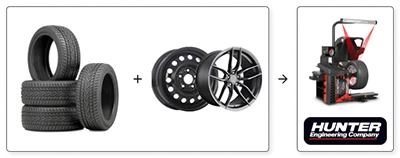What to check before going on a road trip to Canada or the United States?

Summer is the perfect time to go on a road trip, whether it's to one of the beautiful regions of Quebec, a beach in the Maritimes, in the Rockies or the United States. However, if you're thinking of going, make sure you take the necessary precautions with your vehicle to ensure your road trip goes smoothly. Since we want to help make your vacation unforgettable, we offer you some tips to help you prepare your car or your van correctly before you leave!
If you are already aware that your vehicle needs an oil change, new wipers, a replacement bulb or a new windshield, avoid waiting until the last minute to remedy the situation. If any of the dashboard lights are on, or if you're unsure about the general condition of your car, ask your mechanic for a complete diagnostic; after all, prevention is better than cure! Otherwise, the following few checks should ensure a comfortable trip!
1. Check your fluid levels
As you may already know, your vehicle's fluids are necessary for its proper functioning. And keeping them at the appropriate level will save fuel and keep your car running longer. So it's in your best interest to check the status of each of these: engine oil, coolant, power steering fluid, brake fluid, transmission fluid and windshield washer fluid. To check the fluids, park your vehicle on level ground and wait for the engine to cool down completely. If you are unsure of the location of the various reservoirs, consult your owner's manual.
Engine oil acts as a lubricant; it is essential to the proper operation of your car. To check the level, remove the dipstick, wipe it with a rag, dip it back in, then remove it again. If necessary, add oil, but don't put in more than the marker tells you. Visit your mechanic if the fluid is black, gritty, or below the minimum required. Coolant absorbs heat generated by the engine, which then dissipates as it circulates through the radiator. Driving with an insufficient level of this liquid would cause the engine to overheat. It is imperative to wait until your vehicle's engine is cold before undertaking the check. The opposite could be dangerous. If there is not enough fluid, add some. Talk to your mechanic if the fluid level is below the minimum or the tank appears to be leaking. Power steering (or power steering) fluid allows you to turn the steering wheel quickly; if you have trouble handling it, the fluid level is probably too low. To locate the reservoir: Please consult your owner's manual: its location differs from vehicle to vehicle. Before adjusting the amount, check the colour of the fluid; it should be light pink or orange. If it is brown or black, visit your garage. If the brake fluid level is between the recommended maximum and minimum, everything is fine. However, visit your mechanic if it is below the minimum level or black or brown. There could be a leak in the reservoir or too many impurities in the fluid. A drop in brake fluid usually indicates that your brake pads are worn to the point of requiring service. If you hear noises when you shift gears, it's probably the transmission fluid. The location of its reservoir and the process of checking it varies by vehicle model; in some cases, only a professional will be able to inspect it. We recommend that you refer to your owner's manual before checking. Last but not least is the windshield washer fluid. While it doesn't directly affect your vehicle's performance, it is essential for safe driving. Before you leave, be sure to fill the windshield washer fluid tank to the maximum level.
2. Check your tires
For safety, comfort and fuel efficiency, it's essential to check your tire pressure before a long trip. Over-inflated tires reduce handling and grip; under-inflated tires make for an unstable ride, increase fuel consumption, and risk blowouts. In all cases, inadequate air pressure causes premature and uneven tire wear. Before you leave, also check the condition of your tires by measuring their tread. If the tread thickness is less than 1.6 mm, it's time to replace your tires. Whatever your vehicle, you'll find the perfect tires for your needs at PMCtire.com.
3. Make sure your brakes are in good condition
While you can do a cursory check of your brakes yourself, we recommend that you make an appointment with your mechanic to have a complete inspection of the various components of the braking system. Brakes in poor condition could be a threat to your safety.
4. Change your air filters as needed
Your vehicle has two air filters: one in the cabin and the engine. The cabin air filter cleans the air you breathe while your car is running. It is located under the glove compartment in most vehicles and is easily accessible. The engine filter has a significant impact on performance and fuel consumption. It is located under the hood, usually in a square or rectangular box connected by a large black pipe.
Theoretically, these filters (which cost between $15 and $30) should be replaced every year. If they are opaque, it is high time to change them! Of course, you can use your owner's manual to help locate the filters. If you're not comfortable changing them yourself, make an appointment with your mechanic!
5. In your vehicle, make sure you have:
Your owner's manual; Your papers (driver's license, registration, insurance, passport, etc.); A spare tire; Booster cables; A GPS or road maps; A first aid kits.
Can I travel abroad?
The Canada–U.S. land border reopened on November 8, 2021, for fully vaccinated travellers, despite the Government of Canada’s advisory to avoid all non-essential travel outside the country, to the United States or elsewhere on the planet.
There you go! You're all set! Have a great trip! #vanlife #roadtrip


